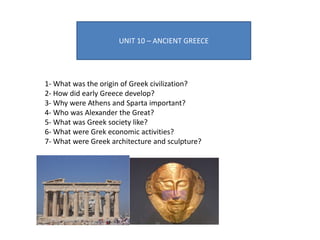
Unit 10 Ancient Greece
- 1. UNIT 10 – ANCIENT GREECE 1- What was the origin of Greek civilization? 2- How did early Greece develop? 3- Why were Athens and Sparta important? 4- Who was Alexander the Great? 5- What was Greek society like? 6- What were Grek economic activities? 7- What were Greek architecture and sculpture?
- 2. EARLY GREECE South of the Balkan P. Eastern Meditarranean 1- Mountains divide the territory into small valleys. Ancient Greece was never a unified country. 2- Greek lands were not very productive. They obtained their food from the sea. They looked for new lands abroad: Greek expansion and colonization (page 113) Location Geographical features
- 3. Main Greek city-states. City-state (Polis): It was a city with its own government, laws, army and way of life. They appeared during the Archaic Age.
- 4. Greek territories 8th C. Territories with Greek influence and Greek colonies Greek colonies Polis Greek expansion Causes Increase of the population No productive land Migration and colonies foundation Eastern Iberian P. Southern France Sicily Southern Italy Coast of the Ionian Sea Coast of the Black Sea
- 5. 1- EL NACIMIENTO DEL MUNDO GRIEGO Los micénicos o aqueos fueron los primeros griegos que posteriormente fueron desplazados por los dorios. 1.3 LOS PRIMEROS GRIEGOS
- 7. During the 6th c. BC the Persians expanded their territories and conquered the Greek Poleis in Asia Minor. The Persian EmpirePersian wars Greek Poleis
- 8. First Persian War ended in 490 BC when the greeks won the battle of Marathon. In the Second Persian War Athens is destroyed (480 BC) but the Persians were defeated at the battle of Salamis. Persian wars
- 9. According to Herodotus, the 192 fallen Athenians are buried under this tumulus located on the plain the battle took place.. The Battle of MArathon According to legend, an Athenian messenger was sent from Marathon to Athens, a distance of about 25 miles (40 km), and there he announced the Persian defeat before dying of exhaustion. This tale became the basis for the modern marathon race. Miltiades, Greek general, ordered a general attack upon the Persian infantry. 6400 Persians died under this attack.
- 10. The Peloponesian Wars Sparta and other poleis saw the dominion of Athens as a threat The war started between Athens and its allies; and Sparta and its allies in 431 BC. The war ended in 404 with the Spartan victory and became the most powerfull polis.
- 11. Macedonia was a kingdom in the north of Greece. Philip II of Macedonia conquered the Greek poleis due to their weakness. Philip was assassinated and Alexander succeeded him. AristotlePhilip II Alexander the Great and Hellenism
- 12. Alexander the Great and Hellenism Alexander conquered the Persian Empire between 334 and 323 BC and reached the Indus river. Alexander’s goal was to build an empire by mixing Greek and Oriental culture. Alexander the Great is one of the biggest conquerers in Human history.
- 13. HELLENISTIC MONARCHIES When Alexander died, his generals divided up the territory and founded different kingdoms.
- 14. Greek society Highly unequal society Citizens Non Citizens Foreigners: free, paid taxes, worked in trade and crafts Slaves: No free, POW, agriculture Women: No rights, under the rule of a man Took part in politics Paid taxes Enjoyed rights Describe the society of Athens.
- 15. Greek society x x x x x x x x x x at
- 16. Economic activities Long distance trade Local commerce CRafts Agriculture Imported food, wood and cooper. Exported Greek products Small shos in Greek cities. Land was poor Wine, wheat and olives. Which were the main economic activities?
- 17. Architecture: temples Temples were the most important buildings the Greeks constructed. Built in white marble and painted in different colours Rectangular in shape. Plan of a greek temple
- 18. The three orders in Greek art Architecs followed stricted rules called orders to show proportion, beauty and harmony. The three orders were: Doric Ionic Corinthian You have to focus on the capital to find the most important differences.
- 19. The three orders in Greek art
- 20. LOS ÓRDENES ARQUITECTÓNICOS To which order belong the temples below? To which order belong the capitals below??
- 21. Sculpture: the Archaic period Static and rigid figures. Inspired by the Egiptians KORE KUROS
- 22. Sculpture: classical period Aphrodite (goddess of love(Praxíteles) Charioteer of Delphi (unknow artist) Hermes by Polícleto Discobolus by Myron Sculptures became realistic and show movement (less static and rigid).
- 23. LA ESCULTURA EN LA ÉPOCA HELENÍSTICA Galo moribundo (3rd c BC) Laocoon and his sons (1st c. AD) In Hellenistic Age sculpture reached the higgest point in realism and dramatisation by showing feelings through the statues.
- 24. The PArthenon Built in the 5th c. after the 2nd Persian War by Ictinus and Callicrates under Phidias’ supervision Built on the Acropolis of Athens as a shrine to Athena (goddess of wisdom).